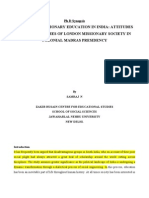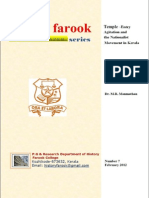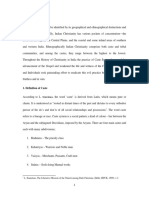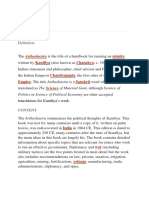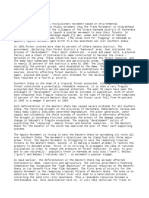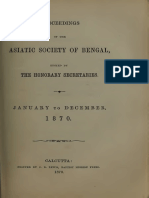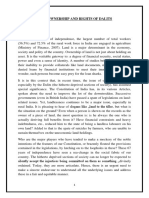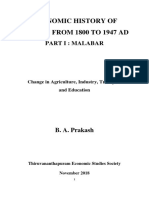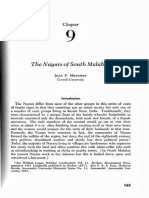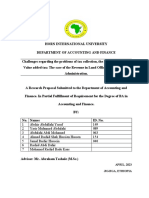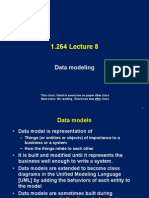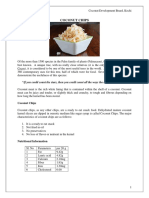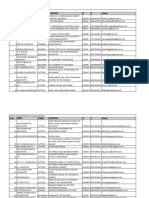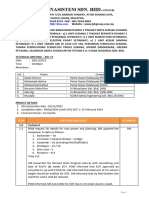CHAPTER I
THE DEPARTURE FROM TRAVANCORE TO MALABAR
It is impossible to exaggerate the significance of migration in developing nations. It is a vital
component in the planning of human resources and economic growth. In light of the commercialization of
agriculture, progress in the settled area’s economy, increase in demography, etc., it has taken on unique
importance. Parallel to this, it is important to analyse how migration affects local residents’ social and
cultural lives. It is a common phenomenon that people move from one place to another for a temporary or
permanent settlement for social, economic, political, religious, or other reasons. Although population
migrations have existed for as long as there have been humans, the modern, large-scale population
movements have wider social, economic, political, demographic, and ecological implications.
Kerala State has a long history of serving as a heaven for immigrants. Jews, Arabs, Syrian Christians,
Konkani Brahmins, Tamil Brahmins, and a host of other ethnic groups have all immigrated to Kerala at
different times throughout history and settled there. Similar to this, Keralans are currently leaving their home
state in search of employment in other countries. Many of them have moved to different regions of India, but
some have chosen to travel abroad. The immovable peasants of Travancore have simultaneously moved to
various regions of Kerala itself. The present research concentrates mostly on the migration of
peasants within Kerala.1
Malabar’s upland areas were populated by Travancore peasants who had migrated there. The majority
of them were Syrian Catholic Christians; as a result of their settlements, churches, and schools were built,
becoming lights of knowledge in the Malabar forests.
This type of research enables scholars to understand historical trends in the past. This chapter covered
the situations in Travancore at the time of the migration as well as the key driving forces behind it. The
northern region of the State of Kerala is referred to as “Malabar”. Six northern districts of the state have
been formed from the region: Kasargod, Kannur, Wayanad, Kozhikode, Malappuram, and Palakkad. The
erstwhile native states of Travancore and Cochin were merged with Malabar to form the State of Kerala.
1
P. T. Sebastian, Christian Migration To Malabar 1930-1980, Department of History, University of Calicut,
2002, p.2.
�Malabar was a part of British India and then Madras State before Independence. Since 1928, an
unprecedented number of individuals from Travancore have migrated to this “foreign” land.
The movement of hardworking and enterprising individuals from the south, where there was a
considerably greater percentage of literacy, was extremely beneficial for Malabar, which was known for its
relative backwardness. Along with bringing their own culture and traditions to Malabar, the migration made
a significant contribution to the region’s educational and cultural advancements. It is important to
specifically emphasize how migration has impacted the economies of Malabar and Kerala in general. Some
of the characteristics that should be addressed include the large-scale production of commercial crops
including rubber, ginger, pepper, areca nut, and coconut, sophisticated cultivation techniques, and the
introduction of new agricultural products. The introduction of the food crop tapioca, which was mostly
unknown in Malabar, deserves special attention. The immigrant-introduced tapioca was so widely grown.
During the early 1940s famine, tapioca prevented starvation in Malabar.
In addition, it is always believed that the settlers from Travancore brought a special variety of pepper
vine that bears fruit every year starting in the second year, as opposed to the Malabar pepper that bears fruit
later and only twice a year. 2 Also, they introduced rubber seedlings with larger yields and better quality.
Along with expanding the cultivation of existing crops and introducing new ones, the settlers also made
large tracts of privately owned forest land available for farming. Before the arrival of the immigrants,
European businesses in Wayanad had complete control of the plantation industry in Malabar. It was carried
throughout Malabar by the settlers. The following effects on employment, trade, and commerce were very
significant. As a result, migration to Malabar involved a massive revolution and marked a significant period
in Kerala’s social, economic, and cultural history.
WHY MIGRATION – POSING ISSUES WITH MIGRATION
As old as human existence itself, human migration is an ongoing activity. The man was always
moving from one terrain to another in search of better pastures, fertile soil, and wealth. The wants of man are
unlimited. The tendency to move is influenced by a variety of factors and restrictions. These reasons and
limitations include life cycle features like age and the number of children.
2
P. T. Sebastian, Op. Cit., p.6.
� There are generally two types for explanations why certain individuals migrate from one place to
another: (1) Factors that “push” them away from their homes; (2) Factors that “draw” them to particular
other places. People are “pulled” to certain other regions by factors like opportunities for employment and
investment as well as favourable conditions for advancement, while people are “pushed” out of one region
by factors like overpopulation and increased pressure on productive land, inadequate facilities for expansion
and growth, scarcity of food, and political or religious persecution. 3 The sequence of occurrences that led a
significant number of farmers from Travancore to Malabar between 1930 and 1980 will be revealed in the
pages that followed.
The Second World War, which caused a food crisis, was one obvious and significant factor in the
migration to Malabar. At that time, the Travancore region had frequent rice shortages. The issue got worse
since there was a shortage of productive land in Central Travancore as a result of increased strain on
productive land. Several of them desired to travel to the Malabar region in search of easily accessible,
affordably priced cultivable areas.
Land Settlements in Travancore
The land in Travancore was less attractive for reinvestment than it was in Malabar, which was one of
two significant causes that encouraged the migration of farmers to that region. Indian planters had already
started operating in the High Range areas by the 1920s. Before this, English planters began their plantations
in the Kottayam district’s High Range areas. In order to obtain land in these locations for farming, they had
an advantage over the Indians. Planters from India had to go through a number of formal procedures. The
subsequent memorandum of regulations for the sale of wasteland in the hilly areas of Travancore required
them to file an application to the Diwan. On the other hand, British nationals were able to submit their
applications directly to British residents, and these applications were quickly approved. Indian planters were
exempt from this.4
3
P. T. Sebastian, Op. Cit., pp.38-39.
4
‘Regulations and Proclamations of Travancore, 1105-1109 ME Vol.7’, Government of Travancore,
Trivandrum, 1934, pp.614-618.
� In addition to gaining areas suited for crops, British planters also benefited by acquiring Sircar estates.
Sircar land was significant because it was superior and guaranteed a fixed rent and tenure for all time. Apart
from sirkar land, there were other types of land available for farming.
These lands fell into the Edavagai tenurial category, which was not classified as sirkar land or jenmam
land. Members of the royal family owned the Sreepadam estates. Local chieftains like Punjar Raja and
Vanchipuzha Pandarathil owned these holdings. These were essentially freeholds, and the state had no right
to the collection of taxes from these properties in Travancore after the land revenue settlement of 1911. Both
the Jenmi-kudiyan Act of 1896 and the Pattam Proclamation of 1865, which granted full ownership rights
and permitted unrestricted property transfers, did not apply to these two categories of lands. As a result, the
Edavagai and Sreepadam land renters lacked the right to a long-term lease over their holdings. 5 There was an
additional source of land for establishing plantations in the Mundakayam - Peermade region, in addition to
this sirkar land and the free-holds owned by the Punjar Raja and the Vanchipuzha Pandarathil. The
Devaswom land for the Paschima Bhagavathi temple was this. The Pattam Proclamation and the Jenmi-
Kudiyan Act did not apply to these lands hence the tenants did not have the same rights as those who lived
on sirkar or jenmam holdings.6
In addition to these issues with tenancy, the prohibitions on the sale or transfer of land as well as the
tenant’s felling of trees on Paschima Devaswom land added fuel to the fire. “Polichezhuthu” was required of
the Paschima Dewasom land renters. There were undoubtedly limitations on the reinvested profits and the
expansion of agriculture in this region due to the prohibitions on land transfer and the lack of permanent
tenancy that existed in Edavagai and Paschima Dewasom areas.7
Only a region with a class of forward-thinking farmers might be the foundation of peasant migration.
A number of factors would lead to the emergence of such a class of peasants. In Travancore, a number of
administrative changes were made that had a favourable impact on the development of these classes. The
“Pattam Proclamation” of 1865 was one of the historical moments that would have a significant impact on
5
Ibid., pp.618-630.
6
P. K. Michael Tharakan, ‘Intra-regional Differences in Agrarian Systems and Internal Migration: A Case
Study of the Migration of Farmers from Travancore to Malabar 1930-1950’, Centre for Development
Studies, Trivandrum, 1984, p.13.
7
Idem.
�the shape and pattern of migration from Travancore in the subsequent decades. Another notable aspect was
that the sirkar directly owned the majority of the productive land in the former Travancore state. Even
though, it was cultivated by tenant farmers who paid rent under the “Pandaravaka Pattam” form of land
tenure. Even while the tenants of these lands had virtual ownership of the land, they did not have the right to
transfer or sell the land to a third party. Consequently, they were locked to their estates with limited scope
for migration. The Pattam Proclamation granted the tenant complete ownership rights and the ability to
transfer ownership of the land. As a result of successive land reforms, the tenant farmers of Travancore
became peasant farmers. The tenants who cultivated the land owned by temples and Namboodiri landowners
under “Kana Pattam” and other forms of tenancy were also elevated to a position that was roughly
equivalent to that of sirkar tenants.
In Travancore, a powerful class of farmers grew as a result of the state government’s encouragement
to cultivate wastelands and forest lands. Following this, the tenants under the Pandaravaka system of tenancy
owned roughly two-thirds of the whole cultivated area in the Travancore State. The Travancore belt’s land
reform also had the immediate effect of making land a wealthy and marketable source of capital. By selling
their small plot of land, the peasant owners were able to start a variety of businesses, including migration to
far-off hilly regions. During this time, land evolved into a ready source of funding for the peasant
movement.
The new taxation policy implemented in Travancore in 1883 was a significant element in promoting
migration to rural areas in the second half of the 19th century. It had been a really oppressive system. The
owners of the land were required to pay taxes on the area of land that was really under cultivation as well as
numerous additional expensive fees, such as the tax on trees like areca, jack, coconut, and tamarind.8
Changes in Travancore’s Politics
Migration to Malabar received a further boost as a result of political changes in Travancore that had an
impact on the Christian community. The majority of the migrants to Malabar were Syrian Christians, and
they actively took part in the political activities that emerged in Travancore after India’s national uprising. A
mass political movement was established in Travancore by the Christian, Ezhava, and Muslim communities
8
P. T. Sebastian, Op. Cit., pp.44-45.
�in the state to challenge the planned method of representation in the assembly under the 1932 constitutional
reforms. In fact, the Catholic community, through the, All Kerala Catholic Congress (AKCC), had already
petitioned the government in 1930 with a list of their grievances, or “Catholic grievances”, outlining their
problems. The AKCC meeting in Cochin voted a resolution opposing Sir C.P. Ramaswamy Aiyyer’s (the
Diwan of Travancore) motion to declare Travancore independent of the Indian Union; however, SNDP
supported the motion of C.P. Ramaswamy Aiyyer.9
Soon after its founding in 1938, the State Congress launched a state-wide civil disobedience action
against the regime of the then-Diwan Sir C.P. Ramaswamy Aiyer, calling for an efficient government in
Travancore. The Christian community contributed significantly to the State Congress’s movement, and as a
result, they understandably paid a high price. When C.P. Ramaswamy Aiyer took office, The Orthodox
Hindus of Travancore oppressed and discriminated against the Christians. During Marthanda Varma’s
invasion of Northern Travancore in the early half of the 18th century, the Christians were subjected to
temporary poverty and neglect. All political advantages, including access to public services, were denied to
them. Due to the combined size of the Ezhava, Muslim, and Christian populations of Travancore, their
collective action of “Nivarthanam” (abstention), or the boycott of the proposed changes, took on the
characteristics of a genuine popular uprising. This abstention movement can be linked to the development of
the later State Congress movement. the State Congress and its Civil Disobedience Movement severely.
Ramaswamy Aiyer’s policies were to be considered as an effort to harm the interests of the Christian
community in addition to the overall suppression.
The AKCC presented the Maharaja with an Education Memorial on October 15, 1946, that had been
signed by over 2.5 lakh persons. During the protest, the Changanacherry Archbishop was threatened with
arrest, and the AKCC President was taken into custody. In addition to having its headquarters moved from
Alleppey in Travancore to Ernakulam in Cochin State, the AKCC had to deal with numerous judicial cases. 10
Several Christian farmers left Travancore because they felt unsafe due to the state government’s harsh tactics
against the State Congress and the Nivarthana Movement.
9
P. T. Sebastian, Op. Cit., pp.89-90.
10
P. T. Sebastian, Op. Cit., p.91.
� The Syrian Christians were denied a number of socio-economic rights, forcing agriculture their
primary source of income. Yet, until the end of the 19th century, Namboodiris and Nair’s landowners owned
the majority of the productive land, which belonged to Hindu temples. As a result, the Syrian Christians
were dependent more on the interior’s dry lands. Only Syrian Christians had the necessary socioeconomic
background, experience, willingness, and ability to migrate to Malabar in search of productive land, hence
they were the only ones in Travancore who could do so. The first immigrants also urged their friends and
family in their Travancore home areas to move to Malabar.
Commercialization of Agriculture
Commercial farming was then used as a means of raising capital in a subsistence economy. Cash crop
farming also offered a reliable foundation for capital accumulation. Since the demand for Keralan
agricultural products like coconut, pepper, areca nut, ginger, etc. increased quickly on the international
market, such a development occurred in the subsistence economy of Travancore as well as in other regions
of Kerala. Cultivation patterns underwent a considerable change as a result of an increase in demand and
price in international markets. Profit maximization influenced production. Towards the middle of the 19th
century, the price of several cash crops grown in Kerala began to improve. As a result, the Travancore
peasants who raised cash crops started to make more profits, and their levels of income and savings started
to rise steadily.
Large areas of land were mostly occupied by the plantation industry that Europeans began in
Travancore. By the 1930s, Europeans and a few indigenous were given access to around two lakh acres of
land for the plantation sector. The Travancore Government attempted to allot an additional 1.5 lakh acres of
land for the same purpose once more in 1931.11 The poor peasants of Travancore were in great need of
productive land, hence the government’s action provoked considerable discontent throughout the state. The
peasants moved to Malabar as a result of this. The expansion of migration from Travancore to Malabar was
facilitated by the development of commercial agriculture.
The marginal farmers of Travancore had moved to the eastern front hills of Travancore much earlier
than the migration to Malabar, namely to Mundakayam, Peermade, and other High-Range locations. British
11
Ibid., p.49.
�investments primarily went into coffee and tea plantations in the previous century. British planters began
investing in rubber in the High Ranges of Travancore by the first decade of the 20th century. From 1910
onward, a few large farmers from the Meenachil, Thodupuzha, and other midland taluks of Travancore
began to establish rubber plantations as a result of British initiatives. On the High ranges or in and around
their own villages in the Midland taluks, a huge number of small farmers from Travancore’s midland taluks
began growing plantation crops like rubber.12
If the widespread introduction of commercial crops had the greatest impact on Kerala’s agrarian sector
during colonial rule, by the end of the period, plantation crops accounted for roughly 60% of all farmed land.
Tea, coffee, rubber, cardamom, and other crops started to be grown in mountainous areas while coconut was
grown in the midland and along the coast. It should be emphasized that during this time, rice cultivation in
the Kuttanadu region also had a commercial aspect. Reclaiming the Kuttanadu region for paddy farming and
massive tapioca production also helped with the demand for food to some extent. The importance that
commercial crops are now obtaining has increased the rate at which food is imported. The continued import
of food products was due to a shortage of fertile paddy fields for the expansion of paddy cultivation and the
government’s failure to use conventional development methods to create new paddy fields. The farmers in
Travancore were able to maintain plantation agriculture due to the competitive prices of commercial crops.
The Government of India started to promote rubber plantations as a result of the Second World War’s fall of
Burma and Malaya, which raised the demand for rubber for military uses. The constant desire of man to
increase his earnings and savings also played a significant part in migration. Naturally, the wealthier farmers
among them bought the property for the raising of cash crops. Prices for such land increased as a result of
the shortage of such appropriate land. In these conditions, economically weaker peasants decided it was
worthwhile to sell their property and migrate to areas with lower land values. This causes a process of
peasant migration.
Population Density on Cultivable Land
One of the main reasons for migration is the demographic factor. The substantial decline in the death
rate brought on by the establishment of contemporary healthcare facilities in Travancore’s interior tends to
12
P. K. Michael Tharakan, Op. Cit., p.8.
�increase the gap between the death and birth rates.13 Peasant farmers and agricultural workers are likely to
extend cultivation to regions previously thought to be unsuitable for the purpose when population pressure is
actually felt in a subsistence economy. One of the main reasons for migration that worked as a “push” factor
was the demand for farmers to search for more and more land for cultivation to meet the growing need of a
growing family or community due to the increase in population in Travancore. The majority of the migrants
came from Travancore’s midland taluks, particularly Meenachil, Thodupuzha, and Moovattupuzha.
Economic Distress
In Travancore, the land was regarded as the most significant form of wealth. The breakdown of
Travancore’s joint families, the Nair, Ezhava, and Vanjinad Vellala Regulations, the monetarization of the
economy, the operation of the forces of the global market, the conversion of land into a commodity, etc. all
intensified the process of the fragmentation of land holdings.
The general decline became visible in 1926, signaling the start of the 1920s economic depression.
Since 1929, when the price of rubber began to fall, there has been a significant depression that has been felt
in many aspects of development work that was then followed by World War I. 14 This slump has been
catastrophic for cultivators, planters, and agricultural workers. Several rubber estates were temporarily
closed, which resulted in a large loss of employment. Together with their neighbours and wealthy farmers,
the landless agricultural labourers from Travancore traveled to Malabar. They split their time between
working as farm labourers and owning tiny plots of property in Malabar.
Poverty and Starvation in Travancore
These factors made the Travancorean farmers move to migrate to the Malabar hill ranges. From the
1930s, many Travancore peasant farmers migrated to Malabar, where they purchased unused land and turned
it into plantations. The movement was also influenced by the start of World War II, which brought about a
new set of “push” and “pull” factors. The Travancoreans were ‘pushed’ away from their base during World
War II due to an acute food shortage and severe economic misery. A reliable source of food supplies for
13
V. J. Varghese, ‘Land, Labour and Migrations: Understanding Kerala’s Economic Modernity’, December
2009, pp.43-45.
14
Aswathy V. Y and Dr. P. Pushpa Raj, ‘Migration from Travancore to Malabar: A Historical Study’ Vol.5,
2018, p.664.
�India was cut off with the fall of Burma. 15 The cost of rice rose, and widespread black marketing was carried
out. To reduce poverty The Travancore government implemented strict rationing and levied a paddy tax on
the peasants. A five-acre plot in Travancore was required by the peasant to provide food for all the people
who relied on him in the early 20th century. It was undoubtedly challenging to extract enough surplus from
it.16
Moreover, the geography of Travancore did not suit itself for expanding paddy farming on a vast
scale. When World War II started, the cultivation of tapioca, a rice substitute, was declining, but cash crops
like coconut, cashew nuts, pepper, and rubber were increasing significantly in this region. This was
especially true in the taluks of Meenachil, Thodupuzha, and Kanhirappally, where paddy lands were
relatively scarce. Many starving peasant farmers during this time gained optimism when they learned from
the early migrants that there was an abundance of land suited for the growing of crops, including tapioca.
They quickly and for relatively high rates sold their small plots of land, then left for Malabar. Hence started
the peasant farmer migration from Travancore to the Malabar woods.
Illness and Mortality
The last half of the decade cannot be characterized as successful, and as a result, it was not very
favourable to the natural increase in population. Potential parents had gone as a result of epidemics.
According to the Travancore Government’s public health department report, 352 people caught smallpox
within 15 days of March 5th, 1932, and 87 of them died from it. In the 1940s, cholera raged through
Travancore, killing 2338 people. In Poovarani near Palai, smallpox caused 42 deaths between 1929 and
1930, and many people left their homes out of fear of this horrible infectious disease.17
In Travancore, the production of tapioca was severely harmed by a specific tapioca infection. The
plantain disease “Banchitop” had a significant impact on farming in the 1920s and 1930s. Thus, in an effort
to eradicate the virus, the Government of Travancore issued orders for the destruction of all plantain crops.
The terrible flood that hit Travancore in 1921, often known as the “flood of 99”, dealt a severe blow to the
region’s economy. Moreover, severe draughts severely damaged the areca nut, coconut, pepper, and other
15
V. J. Varghese, Op. Cit., p.45.
16
K. G. Sivaswamy, ‘The Exodus from Travancore to Malabar Jungles’ Kerala Relief Centre, Coimbatore,
1945, p.1.
17
P. T. Sebastian, Op. Cit., p.107.
�crops grown in Travancore in 1905, 1912, 1930, and 1938. The floods of 1924 and 1929 were the deadliest
disasters to hit the population during the decade of 1921–1931. It should be highlighted that given their
negative effects these floods had no appreciable impact on population growth.18 They then attempted to
migrate to Malabar.
HISTORIOGRAPHIC CRITIQUE
People moving from one place to another has been a common occurrence throughout the development
of human civilization. Also, it is a global experience. People moved in an unprecedented number from
Kerala’s southern region to its northern side throughout the 20th century in pursuit of productive wastelands.
Many books have been published in the past few decades that cover the various aspects of peasant migration.
Indeed, there are a few studies that look at how migrants and natives interact in Kerala. Few books offer
insights into the historical process of these indigenous populations’ alienation from their sources of
production and means of subsistence. The issues of migration and displacement were viewed from various
angles by different academics.
K.G. Sivaswamy first looked into the issue of peasant migration to the Malabar jungles in 1945. He
did so in a study titled The Exodus from Travancore to Malabar Jungles, which documented the lives of
settlers during the early phases of migration. The article portrays a vivid picture of the complex issues
surrounding farmer migration to Malabar. Also, it tells the story of the migrants’ lives in their new
communities. The article also discusses the hardships experienced by the early settlers, including the 1940s
famine, infections, and deaths in Malabar. Through the study, one may learn a lot about the actual living
conditions of the migrants, such as land rents, agricultural practices and crop cycles, agricultural credits,
animals, people’s diets, malaria and other diseases, deaths, etc. The work did not, however, address the
issues surrounding how migration affects both the land and the lives of the people.
P.T. Sebastian offers a broad overview of the entire issue of peasant migration to Malabar in his Ph.D.
research, “Christian Migration to Malabar 1930–1980”. The paper makes the case that the rise of settlements
in Malabar was caused by poverty and famine, economic depression, land systems, commercialization of
agriculture, population pressure on land, political changes in Travancore, etc. In addition, it looks at the
18
Idem.
�peasant migratory pattern, the early settlers’ living conditions, planned migration interventions, the
sociological element of migration, and the socio-economic and political effects of migration. He contends in
his writing that migration greatly aided the growth and development of northern Kerala, but it also led to the
clearing of forests, the exploitation of native people, and other negative effects.
V. J. Varghese made an effort to examine the entire issue of Malabar migration from the perspective
of Kerala’s colonial modernization. The thesis looked at the forces that made migration possible, the
imagination that made it natural, the strategies and agencies of the settlements, and the long-lasting effects of
Malabar migration on the socioeconomic and political landscape of Kerala in an effort to understand the
historical context of the development experience of migration. The same author has written several essays on
the subject that explore various aspects of peasant expeditions to Malabar.
P.K. Michael Tharakan made the first sincere attempt and produced a ground-breaking study on
Malabar migration in 1977. He determines the internal migration of farmers from Travancore to Malabar in
the years 1930 to 1950 and the differences in the agrarian system between regions. In the context of Malabar
migration, he applies the theory of “the push and pull” factors in migration. Growing competition for
productive land in Travancore and the commercialization of agriculture are viewed as “push” reasons, but
the affordability of land for agriculture in Malabar is seen as a “pull” factor for the development of
settlements there. Also, he explores the effects of growing population pressure on land, the Christian
inheritance customs, the fragmentation of property, the commercialization of Travancore’s agriculture, and
other topics. He discusses the issue of Malabar migration initiatives by Syrian Christians. In a different
study, Tharakan looks at the land systems of Malabar and Travancore in relation to migration.
Apart from these studies by scholarly researchers a number of works on peasant migration to Malabar,
have also come to the forefront. Dr. Jaison V. Joseph’s work ‘Malabar Migration and its Impact upon the
Land Utilisation Pattern in Kerala’ portrays the land utilization pattern in Kannur and Kerala in different
periods. He also wrote about the impact of Malabar migration in the agricultural sector of Kerala. Research
works also deal with some of the aspects of Malabar migration. K.C. Zachariah, E. T. Mathew, and S.
Irudaya Rajan wrote on the impact of migration on Kerala’s economy and society. Another work ‘Migration
�from Travancore to Malabar: A Historical Study’ by Aswathy V. Y. and Dr. Pushpa Raj traces the influence
over the social, economic, political, and cultural life of the people of Malabar.







